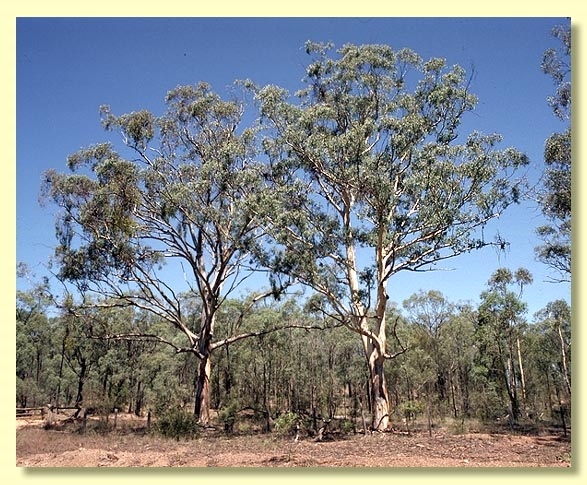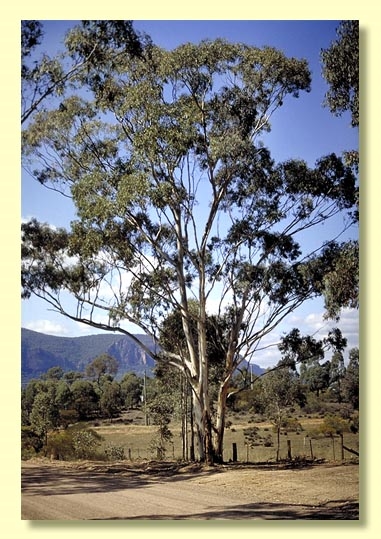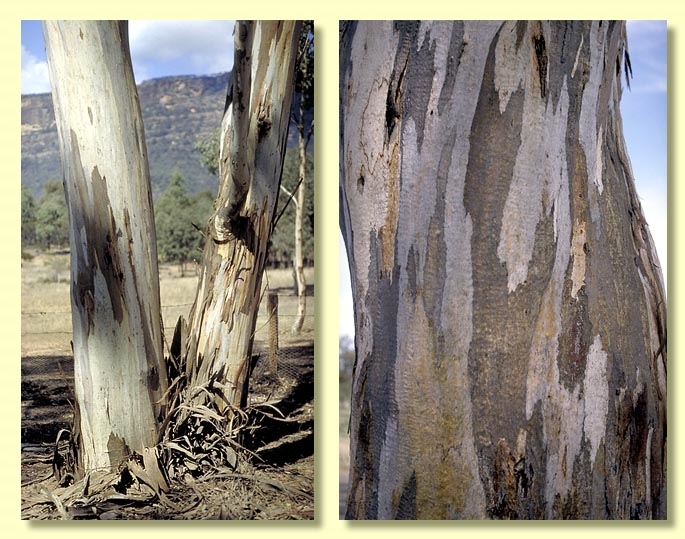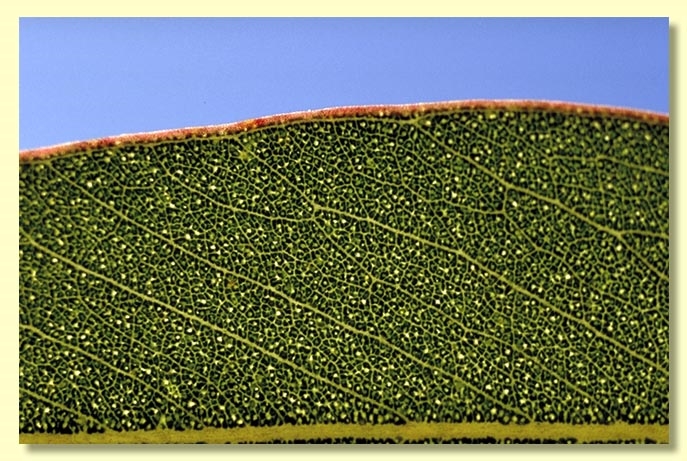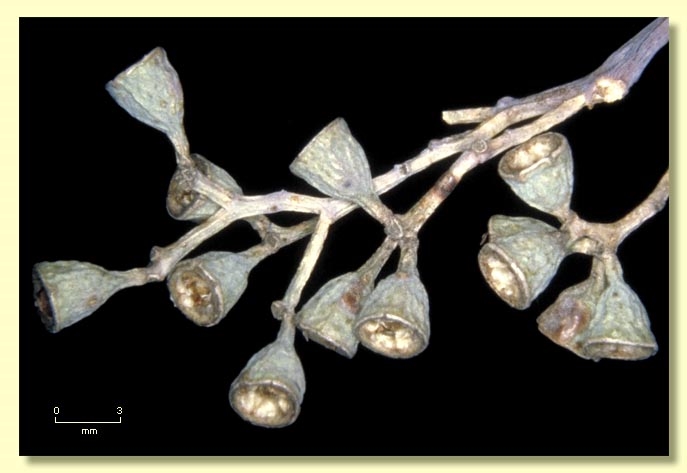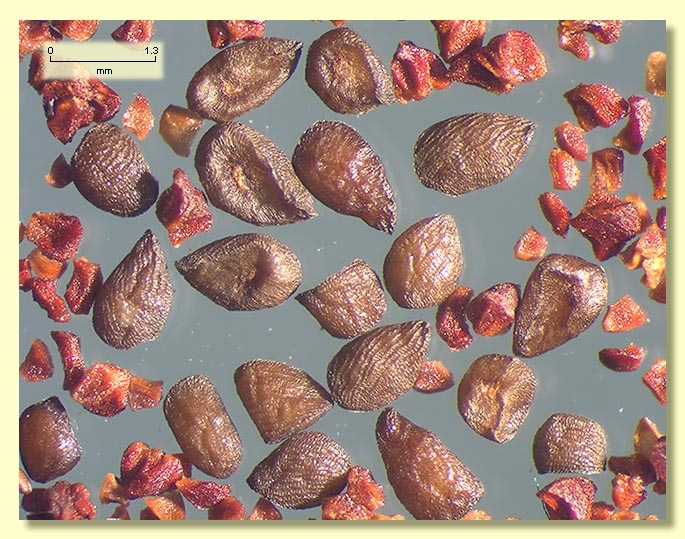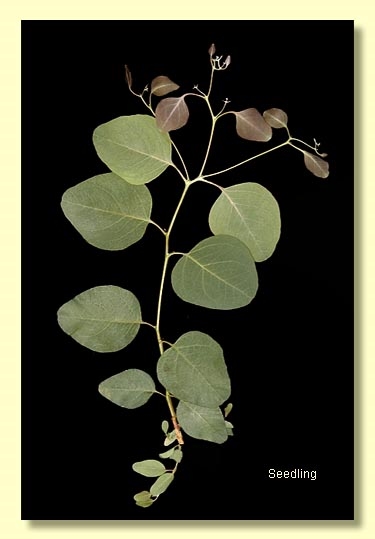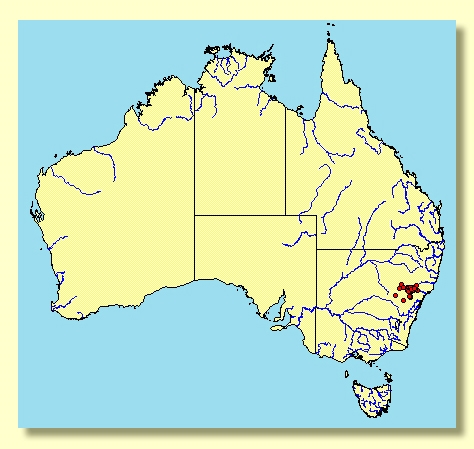Euclid - Online edition
Eucalyptus dawsonii
Eucalyptus | Symphyomyrtus | Adnataria | Apicales | Dawsonianae
T: New South Wales: ranges on the right and left banks of Bylong Creek, Goulburn River, R.T. Baker s.n., November 1892; Lectotype: (NSW19159; isolecto BRI AQ110079, K, NSW326010); fide Bean, A.R., Telopea 12(4): 471 (2010).
Bark smooth to small branches, or with a short stocking of persistent, flaky, grey or grey-brown rough bark; smooth bark often slightly powdery, mottled white, orange, brown, grey or yellow, branchlets glaucous.
Juvenile growth (coppice or field seedlings to 50 cm): stem rounded in cross-section, glaucous; juvenile leaves petiolate, opposite for 3 or 4 nodes then alternate, orbicular to deltoid, 4–9 cm long, 4–7 cm wide, base truncate to tapering, dull, blue-green or glaucous.
Adult leaves alternate, petiole 1.4–3 cm long; blade lanceolate to falcate, 7–16 cm long, 1.2–3.2 cm wide, base tapering to petiole, concolorous, dull, green to blue-green, side-veins at an acute or wider angle to midrib, densely to very densely reticulate, intramarginal vein parallel to and close to the margin, oil glands island and intersectional.
Inflorescence terminal compound, peduncles 0.4–1 cm long, buds 7 per umbel, pedicels 0.1–0.3 cm long. Mature buds obovoid to ovoid, 0.3–0.5 cm long, 0.2–0.3 cm wide, glaucous, scar present, operculum conical, stamens irregularly flexed, all fertile, anthers adnate, cuboid, dehiscing by small terminal or lateral pores, style long, stigma blunt or tapered, locules 3 or 4, the placentae each with 4 vertical ovule rows. Flowers white.
Fruit pedicellate or rarely sessile (pedicels 0–0.3 cm long), obconical or barrel-shaped, 0.3–0.5 cm long, 0.3–0.4 cm wide, glaucous or non-glaucous, disc descending or level, valves 3 or 4, near rim level or enclosed.
Seeds brown, 1–1.7 mm long, flattened-ovoid, often pointed at one end, dorsal surface shallowly pitted, hilum ventral.
Cultivated seedlings (measured at ca node 10): cotyledons reniform; stems rounded in cross-section; leaves always petiolate, opposite for 3 or 4 nodes then alternate, deltoid to orbicular, 6–9 cm long, 3.5–7 cm wide, base truncate or tapering, apex round, green to grey-green, slight waxy bloom on young leaves but not persisting.
Flowering has been recorded in March and November.
A small to medium-sized smooth-barked tree of the box group restricted to an area north-west of the Central Tablelands of New South Wales from west of Muswellbrook to the Kandos district, on slopes and plains. Eucalyptus dawsonii shares the terminal inflorescence and adnate anthers of the box group but differs from most box species by the smooth bark, and the intramarginal vein of the adult leaf very close to the margin. It may resemble E. melliodora, which differs by the axillary inflorescences and inflexed stamens (irregularly flexed in E. dawsonii), and it has been confused with E. polyanthemos subsp. polyanthemos, which differs by having ovate adult leaves and inflexed stamens. All stamens are fertile in E. dawsonii unlike both E. melliodora and E. polyanthemos subsp. polyanthemos both of whic have some infertile stamens.
Eucalyptus dawsonii belongs in Eucalyptus subgenus Symphyomyrtus section Adnataria (the boxes) because the buds have two opercula, ovules are in four rows, seeds are flattened-ovoid, cotyledons are reniform, and anthers are rigid on the staminal filaments. Within section Adnataria, E. dawsonii is taxonomically isolated in series Dawsonianae because of the unusual placement of the intramarginal vein, smooth bark, terminal inflorescence and fruit with valves not exserted.

